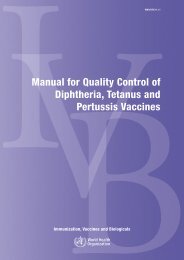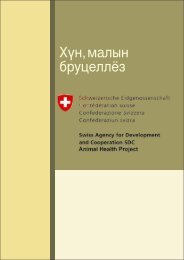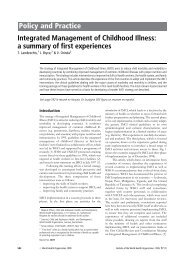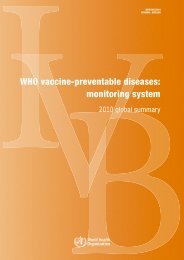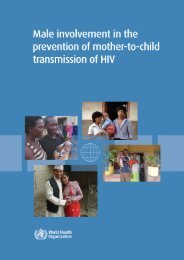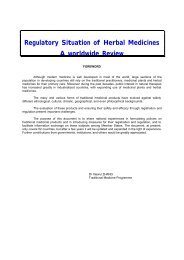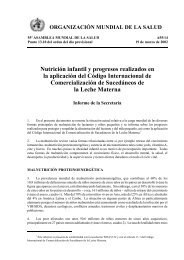IPDE - Extranet Systems - World Health Organization
IPDE - Extranet Systems - World Health Organization
IPDE - Extranet Systems - World Health Organization
You also want an ePaper? Increase the reach of your titles
YUMPU automatically turns print PDFs into web optimized ePapers that Google loves.
20 1. H. Reich and G. de Girolamo<br />
questionnaire and interview assessments of PD generally show a poor<br />
concordance. Therefore, the type of assessment can strongly affect the<br />
rate of a disorder.<br />
To summarize, although different investigators have used different<br />
instmments and populations, the prevalence of PD ranged from 10.3% to<br />
13.5%. a highly consistent prevalence rate of PD in the community. The<br />
rate seems to vary with age. with a slight decrease in older age-groups.<br />
Urban populations and lower socioeconomic groups showed higher<br />
rates. Although the sex ratio is different for specific types of PD. the<br />
overall rates of PD are about equal for the two sexes.<br />
Community epidemiological studies of specified personality<br />
disorders<br />
Table 1 lists the prevalence rates for specific PDs. The majority of the<br />
estimates come From three st~dies.l~,~~~~ In addition, data on the prevalence<br />
of some specified PDs have been reported by Baron et al.,14 who<br />
assessed 750 first-degree relatives of chronic schizophrenics (n = 376)<br />
and normal control probands (n = 374). They administered the subjects<br />
the SADS, the Schedule for Interviewing Borderlines (SIB) and additional<br />
items to diagnose other specific PDs, for which the two interview<br />
schedules did not provide adequate coverage.<br />
Paranoid<br />
Reich er al.15 and Zimmerman and C~ryell'~ have found comparable<br />
rates, ranging from 0.4% to 0.8%. while Maier et ~1.'~ found slightly<br />
higher rates, 1.8%. Baron et al.I4 found a significantly higher rate of<br />
paranoid PD among relatives of schizophrenic probands (7.3%) than<br />
among relatives of control probands (2.7%). This disorder seems to be<br />
more frequent among the members of the lower social classes.<br />
Schizoid<br />
Maier et a1.,I0 Reich et al..IS and Zimmennan and Coryelllz reported<br />
rates ranging from 0.4% to 0.9%. Baron er al.I4 reported a rate of 1.6%<br />
among relatives of schizophrenic probands and to no cases among relatives<br />
of control probands.<br />
Reich et al." and Zimmerman and C~ryell'~ reported rates of 3.0% and<br />
5.6% respectively, while Maier er al.l0 found a substantially lower rate




